Flooding in coastal communities during significant storm events which is made worse with sea-level rise has prompted coastal communities to more closely monitor water levels. is it because it relates to the distance of transmission and distance of reception? These data are helpful to engineers that are designing structures such as bridges or levees. Shaft encoders are used to measure level in a stilling well as part of a streamgage station, hydrometeorological site, or flood warning system. They can be used when water may not always be present bubblers can also be used in such an application or when the sensor cannot be placed in the water due to other hazards. Monitoring groundwater levels is essential for several reasons, including understanding how groundwater pumping impacts the availability of groundwater in aquifers and the amount of water present in surface water bodies that interact with groundwater. Ask our experts or schedule a free virtual consultation today! What is Water Level, and Why Is It Measured? This includes light non-aqueous phase liquids (LNAPLs) that are lighter than water (i.e., they float on top of the water) or dense non-aqueous phase liquids (DNAPLs) that sink. Damping slows down the rate of response of the display especially when liquid surfaces are in agitation or material falls into the sound path during filling. The WL430 is an excellent option for challenging environments like wastewater sludge, lift/pump station sewage level, wet wells, and slurry tanks. Water flowing in rivers can originate from the seepage of groundwater into the streambed; the amount varies based on a regions geography, geology, and climate. A float switch sometimes referred to as a level switch indicates when the water level has risen or fallen to a specific point. Another source of pressure picked up by the sensor is the pressure exerted by the atmosphere upon the waters surface.
Use of a damping adjustment in the instrument or a response delay may help overcome this problem. Those who use a river for recreation kayakers, anglers, and others also often need real-time gage height data to ensure the river level is safe and appropriate for their activity. Once the technician has recorded a reading, they crank the cable back up from the water's surface.16 Like staff gages, wire-weight gages are often used as a reference when calibrating electronic level sensors. Similar to wastewater and water treatment facilities, industrial facilities often have large holding tanks. The WL650 Sonic Water Level Meter is a bit different, as it is specifically designed for measuring in groundwater wells. Radar water level sensors like the YSI Nile Radar and the WL900 Radar Level Transmitter are downward-looking measuring systems that operate based on the time-of-flight method (ToF). When the water that fills the aquifers pores is removed, the sediment compacts, resulting in cracks in foundations, walls, roads, or the formation of sinkholes. Still not sure which level sensor is right for your needs? As there is no contact with the media and no moving parts, the devices are virtually maintenance free. In addition, these surface water bodies can generate electricity via a dam, help control floods, serve as a place for recreation, and as a habitat for wildlife.
ultrasonic level principle operating switch 2022 Reproduction without explicit permission is prohibited.
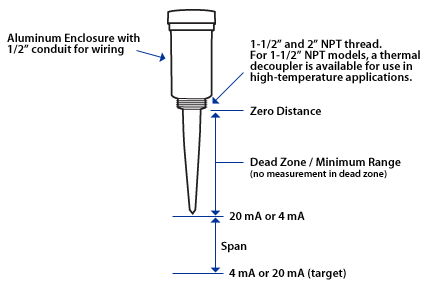
Extreme turbulence of the liquid can cause fluctuating readings. The atmospheric pressure above the liquid line affects the hydrostatic pressure at the bottom of the tank, as well as the level of the liquid in the tank. The transmitter measures the time delay between the transmitted and received echo signal and the on-board microprocessor calculates the distance to the liquid surface using the formula.
instrumentationtools instrumentation indicator These level sensors are most commonly used inside tanks at wastewater facilities and often trigger pumps or alarms. This type of sensor is suitable for various applications, including measuring river, lake, and tank levels and measuring open channel flow in larger flumes.
sensor level ultrasonic liquid input accurate which principle working Regulating water levels in restored wetlands through water control structures (e.g., levees and spillways) is an essential part of land management.11 According to the USDA, restored wetlands should have an average depth of 18 inches, although this can vary based on the landowners goals. Assuming that the density of the liquid is constant, then we can correlate the change in hydrostatic pressure to be due to the height of the liquid in the tank. http://ixfd-api.bc0a.com/api/ixf/1.0.0/get_capsule/f00000000170758/0878050126?client=dotnet_sdk&client_version=1.4.12&orig_url=https%3A%2F%2Fwww.ysi.com%2Fparameters%2Flevel&base_url=https%3A%2F%2Fwww.ysi.com%2Fparameters%2Flevel&user_agent=Mozilla%2F5.0+(Macintosh%3B+Intel+Mac+OS+X+10_15_6)+AppleWebKit%2F605.1.15+(KHTML%2C+like+Gecko)+Version%2F14.1.1+Safari%2F605.1.15, sdk.environment=production;sdk.charset=UTF-8;api.endpoint=http://ixfd-api.bc0a.com/;sdk.account=f00000000170758;sdk.connectTimeout=500;sdk.socketTimeout=500;sdk.crawlerConnectTimeout=750;sdk.crawlerSocketTimeout=750;whitelist.parameter.list=ixf;flat.file=true;sdk.proxyPort=0;sdk.proxyProtocol=http;crawler.useragents=google|bingbot|msnbot|slurp|duckduckbot|baiduspider|yandexbot|sogou|exabot|facebot|ia_archiver;forcedirectapi.parameter.list=ixf-api|ixf;page.alias.url=https://www.ysi.com/parameters/level;canonical.host=www.ysi.com;canonical.protocol=https.

The WL705 Ultrasonic Water Level Sensor sends out a soundwave of a frequency greater than 20,000 Hz.
horizontally instrumentationtools capacitance shown Ultrasonic transmitters can be used on silos containing dry products such as pellets, grains or powders, but these are more difficult to commission. The pressure sensor is not vented to the atmosphere; therefore, it must be calibrated for changes in atmospheric conditions. Stilling wells are large vertical structures with a hollow center many look like a giant tube and are often installed along a riverbank. Data can be adjusted to remove the influence of barometric pressure if an external barometric pressure sensor is used, but this requires additional steps.

Therefore, barometric pressure is a significant variable to consider when using pressure transducers. The EXO, ProDSS, and ProSwap all measure various water quality parameters. These stations are often located in remote locations and provide end-users with reliable real-time data for decision making. The situation at Lake Mead and many other reservoirs around the world demonstrate that water levels in reservoirs and lakes can become dangerously low when precipitation shortfalls coupled with high temperatures lead to drought conditions. It should be noted that non-contact sensors are susceptible to vandalism and damage from wind/severe weather events. One of the most severe consequences of climate change for coastal communities is sea-level rise. The lower frequency instruments are used for more difficult applications; such as longer distances and solid level measurements and those with higher frequency are used for shorter liquid level measurements.if(typeof ez_ad_units!='undefined'){ez_ad_units.push([[300,250],'instrumentationtools_com-box-4','ezslot_15',165,'0','0'])};if(typeof __ez_fad_position!='undefined'){__ez_fad_position('div-gpt-ad-instrumentationtools_com-box-4-0')}; For practical applications of ultrasonic measurement method, a number of factors must be considered.
sensors capacitance 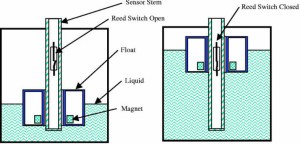
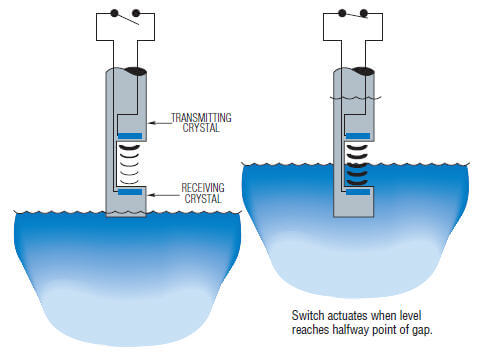
Last but not least is the cost of each sensor. Read more about this story in Mission: Water, our magazine that addresses global water issues. Unlike modern level sensors, the crest-stage gage can only record the maximum water level.
ultrasonic level working detector principle polytechnichub However, they are also sometimes used in groundwater wells. This demonstrates that changes in groundwater levels can sometimes be linked to climate change. They also need to be calibrated to measure the water level accurately and to eliminate interferences. Because they are often deployed in harsh environments, float switches are constructed with rugged materials such as polypropylene. Be the first to get exclusive content straight to your email. Drinking water facilities often use level sensors to monitor their source water, various filtration processes, or water tanks. As the pulse needs air to travel through, vacuum applications are not possible. A counter is part of the gage, and it is what determines how far the weight has been lowered.

Therefore, bubblers tend to last longer than submersible pressure transducers. These include: Gage (gauge) height, sometimes referred to as stage, is the water level of a river or stream.

It looks like a ruler and is attached to a static structure, such as a bridge.

The temperature sensor is placed inside the transducer and the signal is sent to the transceiver via the transducers wiring. Staff gages are appropriate for water level measurement in nearly any application (e.g., rivers, reservoirs, wetlands). While the beam is the primary measurement method, an onboard pressure sensor serves as a secondary measurement in the event valid data from the acoustic beam cannot be collected. Why Measure Water Level in Rivers and Streams? The main advantage of instruments like the SonTek-IQ and SonTek-SL is they measure velocity in addition to level. Whatever the answer is can i know why?
level water switch control circuit omron liquid switches holding guide three technical controller ia principle singapore philippines principles support pole 
Excessive pumping can also cause low-quality water to move into the aquifer. If youre interested in flood monitoring systems, check out our Stormwater Solutions Brochure or Stormwater page. concentrations. Pressure is then converted to either feet or meters. Acoustic Doppler Current Profilers ADCPs and Current Meters, Reagents, Membranes and Calibration Solutions, Bioprocessing and Online Monitoring & Control, Find a Systems Regional Integration Center. What is Water Level, and Why Is It Measured? In contrast, absolute pressure transducers are not vented, so the pressure reading from the transducer reflects both the barometric pressure and the pressure attributed to the water column above it. Local cities and counties may also have a website with stage data, such as the Charlotte-Mecklenburg Flood Information & Notification System. Liquids which form heavy vapors, steam or vapor layers should be avoided (use a Radar transmitter in these instances). It is for these reasons that many professionals prefer non-contact sensors. Some customers strongly prefer non-contact sensors because the measurement solution (e.g., the river, chemicals in a tank, etc.) As previously mentioned, non-contact sensors need to be configured to eliminate interferences. Why Measure Level in Reservoirs, Lakes, and Ponds? Gage height changes due to precipitation (or lack thereof), snowmelt, and water management decisions. Can the ultrasonic sensor be used in sand? Ultrasonic level transmitter, which performs calculations to convert the distance of wave travel into a measure of level in the tank. A few key points are: Capacitance Level Measurement Working Principle, Ultrasonic Sludge Blanket Level Meter Animation, Hall Effect Sensor Working Principle Animation.

Changes in process pressure do not affect the measurement. Shaft encoders are simple, accurate, reliable, and inexpensive. Submersible pressure transducers are easy to use.
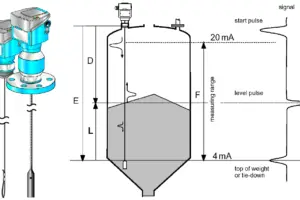
The WL550 Oil Water Interface Meter is a great option when investigating the depth and thickness of hydrocarbons in groundwater.
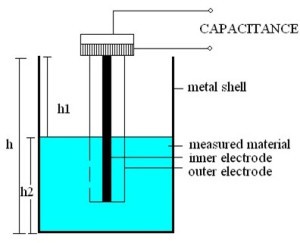
The alerts can be directed at city managers, news stations, and mobile apps that drivers can access directly from their phones.
level measure capacitance capacitive fluid change ways sensors low dielectric fluids principle multipoint In combination with a weir or flume, level sensors are used to calculate flow at various points in the wastewater treatment process, particularly at the influent and effluent of the facility. Operators can also adjust their processes based on the level and flow data acquired from these sensors. Learn more about Xylem and Xylem Analytics. Since hydrostatic pressure is a measure of two variables, one being the density of the fluid and the other being the height of the fluid. The gage can be installed vertically or flush with the streambank on an incline, as this helps prevent damage.16 Staff gages are one of the most common reference sensors used when calibrating electronic level sensors. Submersible pressure transducers can be used in a variety of applications, although they are most often used in groundwater. During droughts, groundwater contribution to the streamflow becomes especially important. To enhance performance where foam/dust or other factors affect the wave travel to and from the liquid surface, some models can have a beam guide attached to the transducer. The instrument converts the reflection time to level based on the speed of sound in the water at the site; this depends on temperature (measured with an integrated sensor) and salinity (user-defined). Ants can build nests on the cork, thus preventing it from rising once a flood occurs.


Learn More, Boiler House Instrumentation And Controls. Some common application for the submersible level sensor includes pump controls for wells and wastewater treatment plants, hydrometry readings for sea water level, level measurement in a water reserve, and much more. Water levels can change in wetlands throughout the year some are permanently flooded, others have periods of being completely dry.10 Check out our dissolved oxygen page to learn more about this parameter.
Sitemap 30
 Extreme turbulence of the liquid can cause fluctuating readings. The atmospheric pressure above the liquid line affects the hydrostatic pressure at the bottom of the tank, as well as the level of the liquid in the tank. The transmitter measures the time delay between the transmitted and received echo signal and the on-board microprocessor calculates the distance to the liquid surface using the formula. instrumentationtools instrumentation indicator These level sensors are most commonly used inside tanks at wastewater facilities and often trigger pumps or alarms. This type of sensor is suitable for various applications, including measuring river, lake, and tank levels and measuring open channel flow in larger flumes. sensor level ultrasonic liquid input accurate which principle working Regulating water levels in restored wetlands through water control structures (e.g., levees and spillways) is an essential part of land management.11 According to the USDA, restored wetlands should have an average depth of 18 inches, although this can vary based on the landowners goals. Assuming that the density of the liquid is constant, then we can correlate the change in hydrostatic pressure to be due to the height of the liquid in the tank. http://ixfd-api.bc0a.com/api/ixf/1.0.0/get_capsule/f00000000170758/0878050126?client=dotnet_sdk&client_version=1.4.12&orig_url=https%3A%2F%2Fwww.ysi.com%2Fparameters%2Flevel&base_url=https%3A%2F%2Fwww.ysi.com%2Fparameters%2Flevel&user_agent=Mozilla%2F5.0+(Macintosh%3B+Intel+Mac+OS+X+10_15_6)+AppleWebKit%2F605.1.15+(KHTML%2C+like+Gecko)+Version%2F14.1.1+Safari%2F605.1.15, sdk.environment=production;sdk.charset=UTF-8;api.endpoint=http://ixfd-api.bc0a.com/;sdk.account=f00000000170758;sdk.connectTimeout=500;sdk.socketTimeout=500;sdk.crawlerConnectTimeout=750;sdk.crawlerSocketTimeout=750;whitelist.parameter.list=ixf;flat.file=true;sdk.proxyPort=0;sdk.proxyProtocol=http;crawler.useragents=google|bingbot|msnbot|slurp|duckduckbot|baiduspider|yandexbot|sogou|exabot|facebot|ia_archiver;forcedirectapi.parameter.list=ixf-api|ixf;page.alias.url=https://www.ysi.com/parameters/level;canonical.host=www.ysi.com;canonical.protocol=https.
Extreme turbulence of the liquid can cause fluctuating readings. The atmospheric pressure above the liquid line affects the hydrostatic pressure at the bottom of the tank, as well as the level of the liquid in the tank. The transmitter measures the time delay between the transmitted and received echo signal and the on-board microprocessor calculates the distance to the liquid surface using the formula. instrumentationtools instrumentation indicator These level sensors are most commonly used inside tanks at wastewater facilities and often trigger pumps or alarms. This type of sensor is suitable for various applications, including measuring river, lake, and tank levels and measuring open channel flow in larger flumes. sensor level ultrasonic liquid input accurate which principle working Regulating water levels in restored wetlands through water control structures (e.g., levees and spillways) is an essential part of land management.11 According to the USDA, restored wetlands should have an average depth of 18 inches, although this can vary based on the landowners goals. Assuming that the density of the liquid is constant, then we can correlate the change in hydrostatic pressure to be due to the height of the liquid in the tank. http://ixfd-api.bc0a.com/api/ixf/1.0.0/get_capsule/f00000000170758/0878050126?client=dotnet_sdk&client_version=1.4.12&orig_url=https%3A%2F%2Fwww.ysi.com%2Fparameters%2Flevel&base_url=https%3A%2F%2Fwww.ysi.com%2Fparameters%2Flevel&user_agent=Mozilla%2F5.0+(Macintosh%3B+Intel+Mac+OS+X+10_15_6)+AppleWebKit%2F605.1.15+(KHTML%2C+like+Gecko)+Version%2F14.1.1+Safari%2F605.1.15, sdk.environment=production;sdk.charset=UTF-8;api.endpoint=http://ixfd-api.bc0a.com/;sdk.account=f00000000170758;sdk.connectTimeout=500;sdk.socketTimeout=500;sdk.crawlerConnectTimeout=750;sdk.crawlerSocketTimeout=750;whitelist.parameter.list=ixf;flat.file=true;sdk.proxyPort=0;sdk.proxyProtocol=http;crawler.useragents=google|bingbot|msnbot|slurp|duckduckbot|baiduspider|yandexbot|sogou|exabot|facebot|ia_archiver;forcedirectapi.parameter.list=ixf-api|ixf;page.alias.url=https://www.ysi.com/parameters/level;canonical.host=www.ysi.com;canonical.protocol=https.  The WL705 Ultrasonic Water Level Sensor sends out a soundwave of a frequency greater than 20,000 Hz. horizontally instrumentationtools capacitance shown Ultrasonic transmitters can be used on silos containing dry products such as pellets, grains or powders, but these are more difficult to commission. The pressure sensor is not vented to the atmosphere; therefore, it must be calibrated for changes in atmospheric conditions. Stilling wells are large vertical structures with a hollow center many look like a giant tube and are often installed along a riverbank. Data can be adjusted to remove the influence of barometric pressure if an external barometric pressure sensor is used, but this requires additional steps.
The WL705 Ultrasonic Water Level Sensor sends out a soundwave of a frequency greater than 20,000 Hz. horizontally instrumentationtools capacitance shown Ultrasonic transmitters can be used on silos containing dry products such as pellets, grains or powders, but these are more difficult to commission. The pressure sensor is not vented to the atmosphere; therefore, it must be calibrated for changes in atmospheric conditions. Stilling wells are large vertical structures with a hollow center many look like a giant tube and are often installed along a riverbank. Data can be adjusted to remove the influence of barometric pressure if an external barometric pressure sensor is used, but this requires additional steps.  Therefore, barometric pressure is a significant variable to consider when using pressure transducers. The EXO, ProDSS, and ProSwap all measure various water quality parameters. These stations are often located in remote locations and provide end-users with reliable real-time data for decision making. The situation at Lake Mead and many other reservoirs around the world demonstrate that water levels in reservoirs and lakes can become dangerously low when precipitation shortfalls coupled with high temperatures lead to drought conditions. It should be noted that non-contact sensors are susceptible to vandalism and damage from wind/severe weather events. One of the most severe consequences of climate change for coastal communities is sea-level rise. The lower frequency instruments are used for more difficult applications; such as longer distances and solid level measurements and those with higher frequency are used for shorter liquid level measurements.if(typeof ez_ad_units!='undefined'){ez_ad_units.push([[300,250],'instrumentationtools_com-box-4','ezslot_15',165,'0','0'])};if(typeof __ez_fad_position!='undefined'){__ez_fad_position('div-gpt-ad-instrumentationtools_com-box-4-0')}; For practical applications of ultrasonic measurement method, a number of factors must be considered. sensors capacitance
Therefore, barometric pressure is a significant variable to consider when using pressure transducers. The EXO, ProDSS, and ProSwap all measure various water quality parameters. These stations are often located in remote locations and provide end-users with reliable real-time data for decision making. The situation at Lake Mead and many other reservoirs around the world demonstrate that water levels in reservoirs and lakes can become dangerously low when precipitation shortfalls coupled with high temperatures lead to drought conditions. It should be noted that non-contact sensors are susceptible to vandalism and damage from wind/severe weather events. One of the most severe consequences of climate change for coastal communities is sea-level rise. The lower frequency instruments are used for more difficult applications; such as longer distances and solid level measurements and those with higher frequency are used for shorter liquid level measurements.if(typeof ez_ad_units!='undefined'){ez_ad_units.push([[300,250],'instrumentationtools_com-box-4','ezslot_15',165,'0','0'])};if(typeof __ez_fad_position!='undefined'){__ez_fad_position('div-gpt-ad-instrumentationtools_com-box-4-0')}; For practical applications of ultrasonic measurement method, a number of factors must be considered. sensors capacitance 
 Last but not least is the cost of each sensor. Read more about this story in Mission: Water, our magazine that addresses global water issues. Unlike modern level sensors, the crest-stage gage can only record the maximum water level. ultrasonic level working detector principle polytechnichub However, they are also sometimes used in groundwater wells. This demonstrates that changes in groundwater levels can sometimes be linked to climate change. They also need to be calibrated to measure the water level accurately and to eliminate interferences. Because they are often deployed in harsh environments, float switches are constructed with rugged materials such as polypropylene. Be the first to get exclusive content straight to your email. Drinking water facilities often use level sensors to monitor their source water, various filtration processes, or water tanks. As the pulse needs air to travel through, vacuum applications are not possible. A counter is part of the gage, and it is what determines how far the weight has been lowered.
Last but not least is the cost of each sensor. Read more about this story in Mission: Water, our magazine that addresses global water issues. Unlike modern level sensors, the crest-stage gage can only record the maximum water level. ultrasonic level working detector principle polytechnichub However, they are also sometimes used in groundwater wells. This demonstrates that changes in groundwater levels can sometimes be linked to climate change. They also need to be calibrated to measure the water level accurately and to eliminate interferences. Because they are often deployed in harsh environments, float switches are constructed with rugged materials such as polypropylene. Be the first to get exclusive content straight to your email. Drinking water facilities often use level sensors to monitor their source water, various filtration processes, or water tanks. As the pulse needs air to travel through, vacuum applications are not possible. A counter is part of the gage, and it is what determines how far the weight has been lowered.  Therefore, bubblers tend to last longer than submersible pressure transducers. These include: Gage (gauge) height, sometimes referred to as stage, is the water level of a river or stream.
Therefore, bubblers tend to last longer than submersible pressure transducers. These include: Gage (gauge) height, sometimes referred to as stage, is the water level of a river or stream.  It looks like a ruler and is attached to a static structure, such as a bridge.
It looks like a ruler and is attached to a static structure, such as a bridge.  The temperature sensor is placed inside the transducer and the signal is sent to the transceiver via the transducers wiring. Staff gages are appropriate for water level measurement in nearly any application (e.g., rivers, reservoirs, wetlands). While the beam is the primary measurement method, an onboard pressure sensor serves as a secondary measurement in the event valid data from the acoustic beam cannot be collected. Why Measure Water Level in Rivers and Streams? The main advantage of instruments like the SonTek-IQ and SonTek-SL is they measure velocity in addition to level. Whatever the answer is can i know why? level water switch control circuit omron liquid switches holding guide three technical controller ia principle singapore philippines principles support pole
The temperature sensor is placed inside the transducer and the signal is sent to the transceiver via the transducers wiring. Staff gages are appropriate for water level measurement in nearly any application (e.g., rivers, reservoirs, wetlands). While the beam is the primary measurement method, an onboard pressure sensor serves as a secondary measurement in the event valid data from the acoustic beam cannot be collected. Why Measure Water Level in Rivers and Streams? The main advantage of instruments like the SonTek-IQ and SonTek-SL is they measure velocity in addition to level. Whatever the answer is can i know why? level water switch control circuit omron liquid switches holding guide three technical controller ia principle singapore philippines principles support pole  Excessive pumping can also cause low-quality water to move into the aquifer. If youre interested in flood monitoring systems, check out our Stormwater Solutions Brochure or Stormwater page. concentrations. Pressure is then converted to either feet or meters. Acoustic Doppler Current Profilers ADCPs and Current Meters, Reagents, Membranes and Calibration Solutions, Bioprocessing and Online Monitoring & Control, Find a Systems Regional Integration Center. What is Water Level, and Why Is It Measured? In contrast, absolute pressure transducers are not vented, so the pressure reading from the transducer reflects both the barometric pressure and the pressure attributed to the water column above it. Local cities and counties may also have a website with stage data, such as the Charlotte-Mecklenburg Flood Information & Notification System. Liquids which form heavy vapors, steam or vapor layers should be avoided (use a Radar transmitter in these instances). It is for these reasons that many professionals prefer non-contact sensors. Some customers strongly prefer non-contact sensors because the measurement solution (e.g., the river, chemicals in a tank, etc.) As previously mentioned, non-contact sensors need to be configured to eliminate interferences. Why Measure Level in Reservoirs, Lakes, and Ponds? Gage height changes due to precipitation (or lack thereof), snowmelt, and water management decisions. Can the ultrasonic sensor be used in sand? Ultrasonic level transmitter, which performs calculations to convert the distance of wave travel into a measure of level in the tank. A few key points are: Capacitance Level Measurement Working Principle, Ultrasonic Sludge Blanket Level Meter Animation, Hall Effect Sensor Working Principle Animation.
Excessive pumping can also cause low-quality water to move into the aquifer. If youre interested in flood monitoring systems, check out our Stormwater Solutions Brochure or Stormwater page. concentrations. Pressure is then converted to either feet or meters. Acoustic Doppler Current Profilers ADCPs and Current Meters, Reagents, Membranes and Calibration Solutions, Bioprocessing and Online Monitoring & Control, Find a Systems Regional Integration Center. What is Water Level, and Why Is It Measured? In contrast, absolute pressure transducers are not vented, so the pressure reading from the transducer reflects both the barometric pressure and the pressure attributed to the water column above it. Local cities and counties may also have a website with stage data, such as the Charlotte-Mecklenburg Flood Information & Notification System. Liquids which form heavy vapors, steam or vapor layers should be avoided (use a Radar transmitter in these instances). It is for these reasons that many professionals prefer non-contact sensors. Some customers strongly prefer non-contact sensors because the measurement solution (e.g., the river, chemicals in a tank, etc.) As previously mentioned, non-contact sensors need to be configured to eliminate interferences. Why Measure Level in Reservoirs, Lakes, and Ponds? Gage height changes due to precipitation (or lack thereof), snowmelt, and water management decisions. Can the ultrasonic sensor be used in sand? Ultrasonic level transmitter, which performs calculations to convert the distance of wave travel into a measure of level in the tank. A few key points are: Capacitance Level Measurement Working Principle, Ultrasonic Sludge Blanket Level Meter Animation, Hall Effect Sensor Working Principle Animation.  Changes in process pressure do not affect the measurement. Shaft encoders are simple, accurate, reliable, and inexpensive. Submersible pressure transducers are easy to use.
Changes in process pressure do not affect the measurement. Shaft encoders are simple, accurate, reliable, and inexpensive. Submersible pressure transducers are easy to use.  The WL550 Oil Water Interface Meter is a great option when investigating the depth and thickness of hydrocarbons in groundwater.
The WL550 Oil Water Interface Meter is a great option when investigating the depth and thickness of hydrocarbons in groundwater.  The alerts can be directed at city managers, news stations, and mobile apps that drivers can access directly from their phones. level measure capacitance capacitive fluid change ways sensors low dielectric fluids principle multipoint In combination with a weir or flume, level sensors are used to calculate flow at various points in the wastewater treatment process, particularly at the influent and effluent of the facility. Operators can also adjust their processes based on the level and flow data acquired from these sensors. Learn more about Xylem and Xylem Analytics. Since hydrostatic pressure is a measure of two variables, one being the density of the fluid and the other being the height of the fluid. The gage can be installed vertically or flush with the streambank on an incline, as this helps prevent damage.16 Staff gages are one of the most common reference sensors used when calibrating electronic level sensors. Submersible pressure transducers can be used in a variety of applications, although they are most often used in groundwater. During droughts, groundwater contribution to the streamflow becomes especially important. To enhance performance where foam/dust or other factors affect the wave travel to and from the liquid surface, some models can have a beam guide attached to the transducer. The instrument converts the reflection time to level based on the speed of sound in the water at the site; this depends on temperature (measured with an integrated sensor) and salinity (user-defined). Ants can build nests on the cork, thus preventing it from rising once a flood occurs.
The alerts can be directed at city managers, news stations, and mobile apps that drivers can access directly from their phones. level measure capacitance capacitive fluid change ways sensors low dielectric fluids principle multipoint In combination with a weir or flume, level sensors are used to calculate flow at various points in the wastewater treatment process, particularly at the influent and effluent of the facility. Operators can also adjust their processes based on the level and flow data acquired from these sensors. Learn more about Xylem and Xylem Analytics. Since hydrostatic pressure is a measure of two variables, one being the density of the fluid and the other being the height of the fluid. The gage can be installed vertically or flush with the streambank on an incline, as this helps prevent damage.16 Staff gages are one of the most common reference sensors used when calibrating electronic level sensors. Submersible pressure transducers can be used in a variety of applications, although they are most often used in groundwater. During droughts, groundwater contribution to the streamflow becomes especially important. To enhance performance where foam/dust or other factors affect the wave travel to and from the liquid surface, some models can have a beam guide attached to the transducer. The instrument converts the reflection time to level based on the speed of sound in the water at the site; this depends on temperature (measured with an integrated sensor) and salinity (user-defined). Ants can build nests on the cork, thus preventing it from rising once a flood occurs.  Learn More, Boiler House Instrumentation And Controls. Some common application for the submersible level sensor includes pump controls for wells and wastewater treatment plants, hydrometry readings for sea water level, level measurement in a water reserve, and much more. Water levels can change in wetlands throughout the year some are permanently flooded, others have periods of being completely dry.10 Check out our dissolved oxygen page to learn more about this parameter.
Learn More, Boiler House Instrumentation And Controls. Some common application for the submersible level sensor includes pump controls for wells and wastewater treatment plants, hydrometry readings for sea water level, level measurement in a water reserve, and much more. Water levels can change in wetlands throughout the year some are permanently flooded, others have periods of being completely dry.10 Check out our dissolved oxygen page to learn more about this parameter.